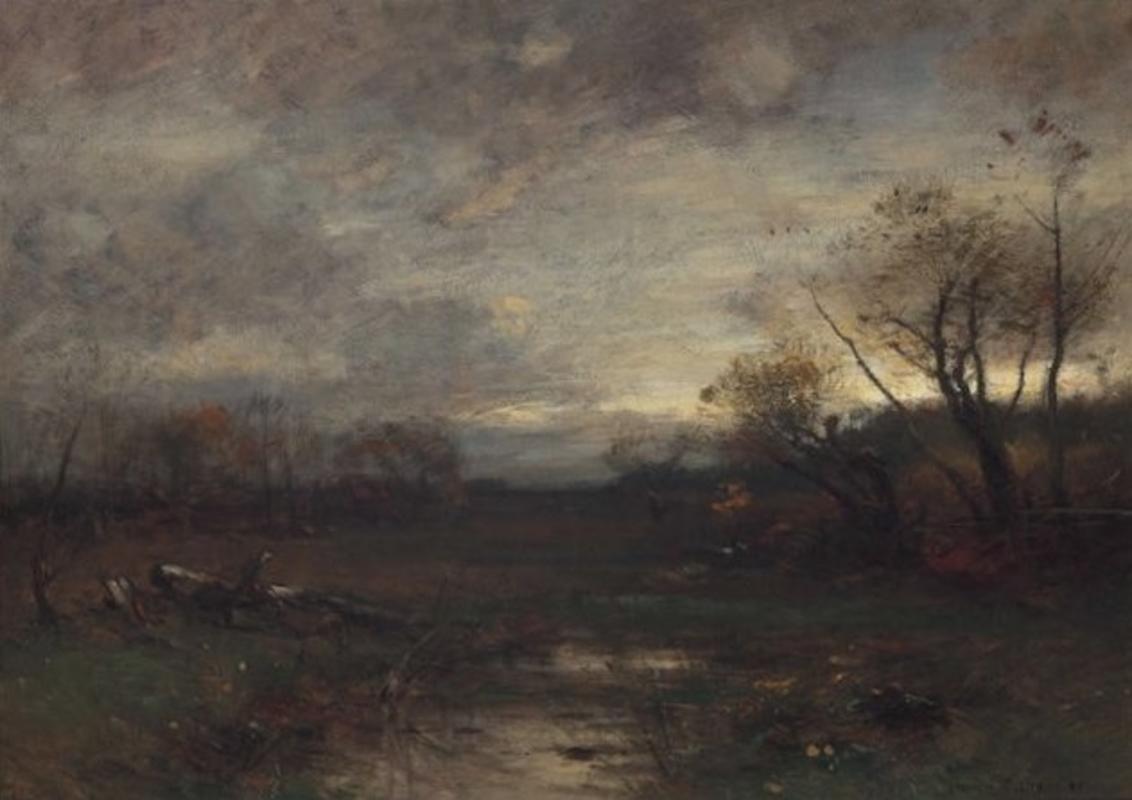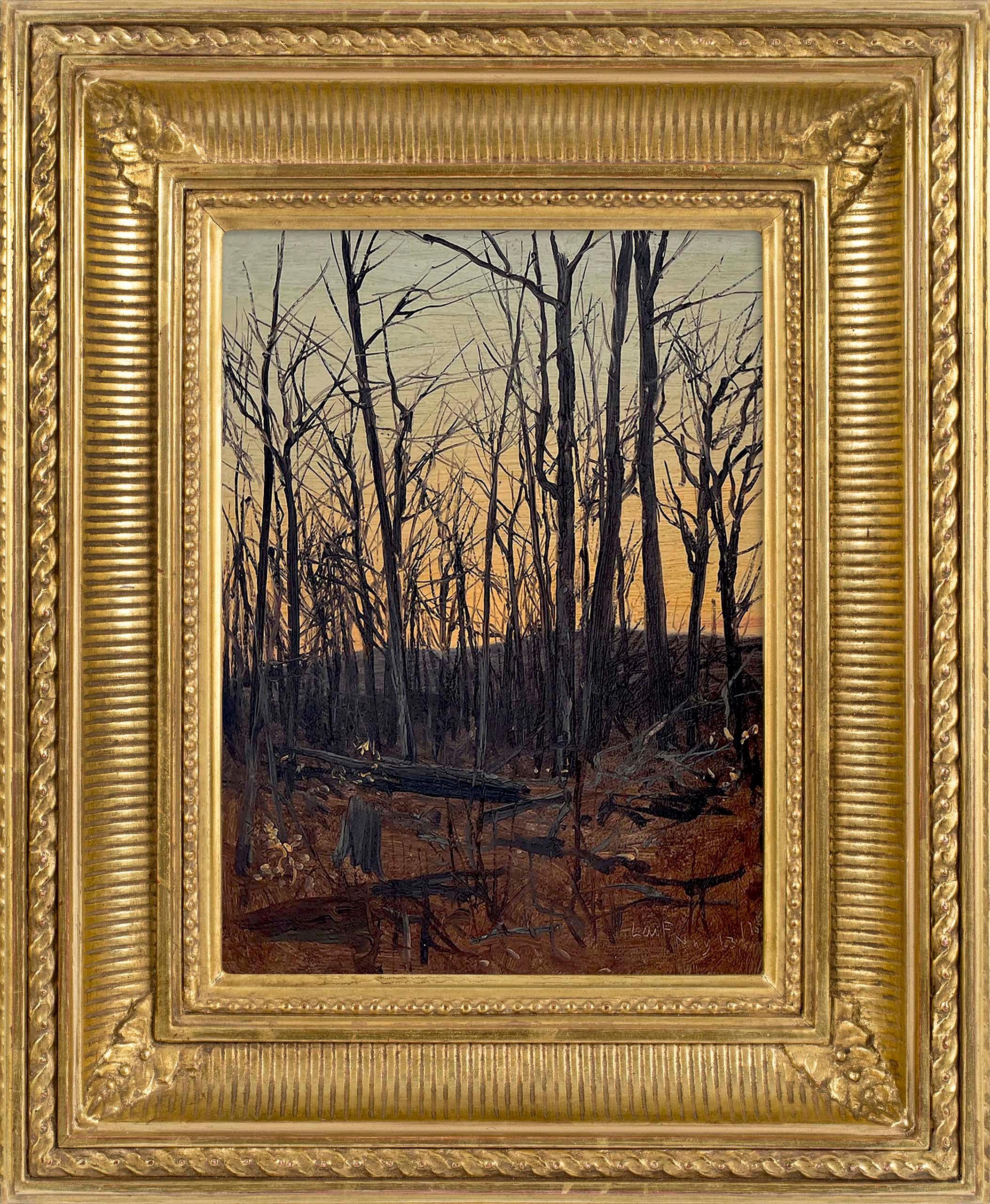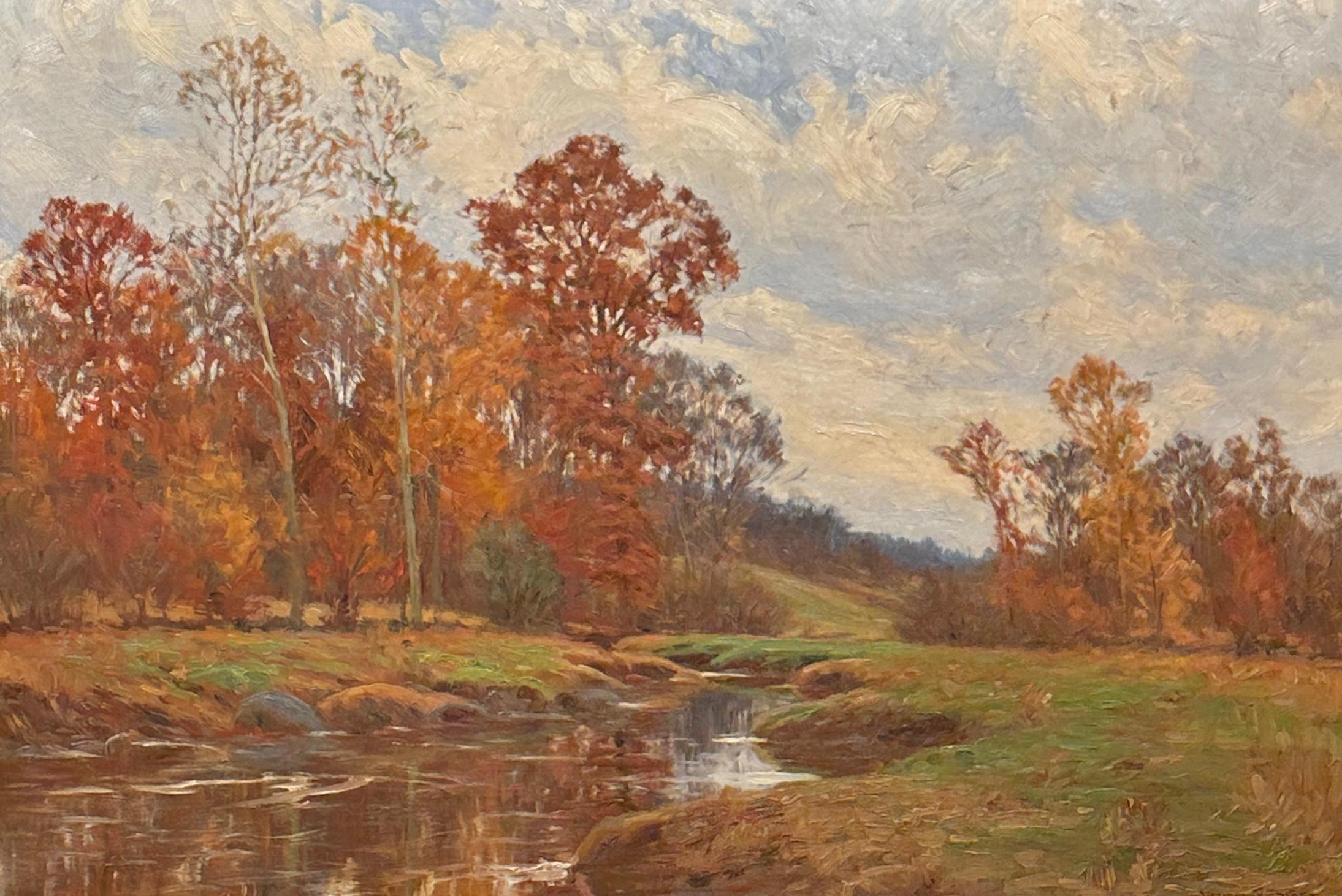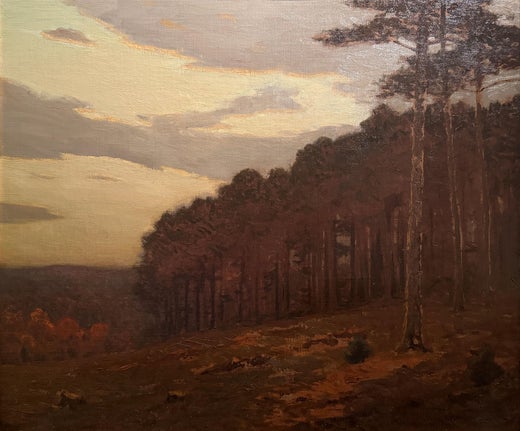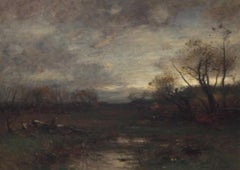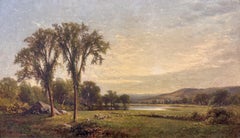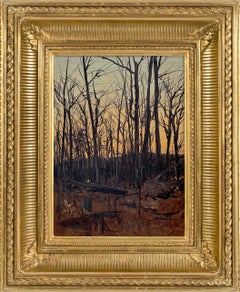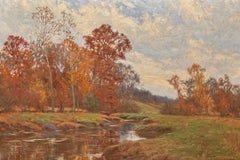Items Similar to "Autumn, New England" Charles Warren Eaton, Tonalist Gloaming Sunset in Woods
Want more images or videos?
Request additional images or videos from the seller
1 of 9
Charles Warren Eaton"Autumn, New England" Charles Warren Eaton, Tonalist Gloaming Sunset in Woodscirca 1900
circa 1900
$16,000
£12,221.49
€14,043.88
CA$22,840.12
A$25,042.39
CHF 13,076.94
MX$301,353.70
NOK 164,813.95
SEK 154,967.51
DKK 104,881.79
About the Item
Charles Warren Eaton
Autumn, New England
Signed lower right
Oil on canvas
30 x 36 inches
Provenance
Private Collection, Connecticut
A contemporary critic wrote that the paintings of Charles Warren Eaton appeal to “the dreamers who find in them the undiscovered scenes in which their fancy long has dwelt.” Eaton’s contemplative landscapes exude a spiritual quality that moves the observer into a similar frame of mind. He loved to depict the ethereal light of dawn and dusk in late autumn or winter, usually without any reference to human or animal figures or buildings. These Tonalist paintings, with their subdued palette and relatively intimate scale, marked a definite break with the fading popularity of the panoramic and romantic views of the Hudson River School painters.
Charles Warren Eaton was born in Albany, New York to a family of limited means. He began painting while working in a dry-goods store. At age 22, he enrolled at the National Academy of Design in New York City and then studied figure painting at the Art Students League. By 1886, he was successful enough to quit his day job and make a living as a landscape painter. That year, he traveled to Europe with fellow Tonalist painters Leonard Ochtman and Ben Foster. In France, Eaton visited popular artist’s spots such as Paris, Fontainebleau and Grez-sur-Loing, and fell in love with the loose brushwork and moody style of French Barbizon painting.
Returning to the United States, Eaton fell under the spell of George Inness, the foremost exponent of Barbizon style in the United States. In 1888, Eaton settled near Inness in Bloomfield, New Jersey, where Eaton lived until his death in 1937. In this period, he painted shadowy and ambiguous landscapes inspired by rural scenery in the northeastern United States. His signature theme was a cropped view of the branches, trunks, and foliage of a pine grove silhouetted against a delicately illuminated sunset or moonlit sky. He painted this vision so often between 1900 and 1910 that he picked up the sobriquet ‘‘The Pine Tree Painter.”
After 1910, Eaton responded to the popularity of Impressionism by using brighter colors and painting sunlit daytime scenes. In 1921, he was hired to paint Glacier Lake, in Glacier National Park by the Great Northern Railroad Company as part of their ‘See America First’ campaign. He produced more than 20 paintings, among the artist's last works, that now poignantly remind viewers of the vast disappearing glaciers. Eaton tended to approach this mountain scenery from an oblique vantage point; he liked to capture small episodes, showing mountaintops nearly obscured by dramatically attenuated screens of fir trees.
Eaton, like many Tonalist artists of his generation such as Henry Ward Ranger, John Francis Murphy, and Charles Melville Dewey, fell into relative anonymity in the mid-twentieth century. However, a resurgence of interest around 1990 has restored his reputation as a pioneer and primary exponent of Tonalism and a painter of intensely serene landscapes that evoke a calm and ambiguous beauty.
- Creator:Charles Warren Eaton (1857-1937, American)
- Creation Year:circa 1900
- Dimensions:Height: 38 in (96.52 cm)Width: 44 in (111.76 cm)
- More Editions & Sizes:Unique workPrice: $16,000
- Medium:
- Movement & Style:
- Period:
- Condition:
- Gallery Location:New York, NY
- Reference Number:1stDibs: LU1841216085192
Charles Warren Eaton
Born in Albany, New York, Charles Eaton became a Tonalist landscape painter much influenced by George Inness. His intimate, moody landscapes were known for subdued golden-brown hues and muted tonal harmonies, and the subject was often the landscape in late autumn, evening time, or winter. These paintings were groundbreaking because they were relatively small in scale and intimate countryside views, which was a departure from the generally popular panoramic, romanticized views of Hudson River School painters. In 1879, he enrolled at the National Academy of Design in New York City and then studied figure painting at the Art Students League with J. Carroll Beckwith. He became a close associate with Leonard Ochtman and Ben Foster, both Tonalist painters, and traveled with them to France and England where each formed their own style in reaction to the pervasive Barbizon style of rural landscape and genre painting. They also visited Holland where Eaton painted many canal scenes. He continued to travel rather extensively, visiting Glacier National Park in Montana in 1921 and returned to Italy in 1910 to 1912 and in 1923. A reclusive bachelor, Eaton maintained a studio in New York City, although he lived in Bloomfield, New Jersey. He painted many snow scenes in white and grey purple tones, but by 1900 was focusing more on the theme of the Berkshire pine forests of New York State. His work got less and less attention as modernism became pervasive, and he became increasingly alone and introspective. He won many prizes including ones at the Salmagundi Club, the Philadelphia Art Club and the 1904 St. Louis Exposition. He was a founding member of the Lotus and Salmagundi Clubs.
About the Seller
5.0
Platinum Seller
Premium sellers with a 4.7+ rating and 24-hour response times
Established in 2022
1stDibs seller since 2022
124 sales on 1stDibs
Typical response time: <1 hour
- ShippingRetrieving quote...Shipping from: New York, NY
- Return Policy
Authenticity Guarantee
In the unlikely event there’s an issue with an item’s authenticity, contact us within 1 year for a full refund. DetailsMoney-Back Guarantee
If your item is not as described, is damaged in transit, or does not arrive, contact us within 7 days for a full refund. Details24-Hour Cancellation
You have a 24-hour grace period in which to reconsider your purchase, with no questions asked.Vetted Professional Sellers
Our world-class sellers must adhere to strict standards for service and quality, maintaining the integrity of our listings.Price-Match Guarantee
If you find that a seller listed the same item for a lower price elsewhere, we’ll match it.Trusted Global Delivery
Our best-in-class carrier network provides specialized shipping options worldwide, including custom delivery.More From This Seller
View All"Autumn Landscape, " Bruce Crane, Tonalist American Impressionist Fall Scene
By Bruce Crane
Located in New York, NY
Bruce Crane (1857 - 1937)
Autumn Landscape
Oil on canvas
25 x 30 inches
Signed lower right
Robert Bruce Crane was an American painter. He joined the Lyme Art Colony in the early 190...
Category
Early 20th Century Tonalist Landscape Paintings
Materials
Canvas, Oil
"November" Bruce Crane, Tonalism Landscape Autumn Scene, American Impressionism
By Bruce Crane
Located in New York, NY
Bruce Crane (1857 - 1937)
November
Oil on canvas
25 x 30 inches
Signed lower right
Robert Bruce Crane was an American painter. He joined the Lyme Art Colony in the early 1900s. His ...
Category
Early 20th Century Tonalist Landscape Paintings
Materials
Canvas, Oil
"Late Afternoon, " J. Francis Murphy Tonalist Summer / Autumn Landscape
By John Francis Murphy
Located in New York, NY
John Francis Murphy (American, 1853 - 1921)
Late Afternoon, 1895
Oil on canvas
14 x 19 inches
Signed and dated lower right
Housed in a reproduction fluted cove frame.
Provenance:
Kenneth Lux Gallery, Inc., New York
BNY Mellon, New York
Christie's New York, Living with Art, October 14, 2016, Lot 352
In his lifetime, John Francis Murphy (1853-1921) was known as “the American Corot.” He was renowned for his small, intimate views of nature, especially barren fields and farms, bare trees, and lonely marshland. More than a century later, the power of Murphy’s landscapes has not waned. One contemporary critic wrote, “It was Murphy’s unique accomplishment to achieve an absolute realism without a loss of that mystic, indefinable quality which transfigures realism.”
John Francis Murphy was born at Oswego, NY in 1853 but his family moved to Chicago in 1868 where he worked painting theater sets. Murphy was basically a self-taught artist; his only formal training was a few weeks of instruction at the Chicago Academy of Design.
In 1875, Murphy moved from Chicago to New York, eventually rooming with the painters Dennis Bunker...
Category
1890s Tonalist Landscape Paintings
Materials
Canvas, Oil
"Farmland Meadows" George Henry Smillie, Hudson River School, Sunset Landscape
By George Henry Smillie
Located in New York, NY
George Henry Smillie
Farmland Meadows, 1865
Signed and dated lower left
Oil on canvas
10 1/2 x 18 inches
Provenance
Private Collection, Langley, Washington
The career of George Sm...
Category
1860s Tonalist Figurative Paintings
Materials
Canvas, Oil
"Stone Wall, Autumn, " George Smillie, Tonalist Fall Landscape View
By George Henry Smillie
Located in New York, NY
George Henry Smillie (1840 - 1921)
Stone Wall, Autumn, 1879
Oil on canvas
9 1/2 x 15 inches
Signed and dated lower right
Provenance:
Skinner, Boston, September 19, 2014, Lot 389
The career of George Smillie (1840-1921) followed the arc of nineteenth-century U.S. landscape painting. Trained in the Hudson River School tradition, Smillie successfully adapted to changing U.S. tastes and growing interest in European trends. In the late 1800s, he moved to tonalist paintings full of brushwork and influenced by French Barbizon painting. By the end of his career, he had lightened his palette to produce works similar to those of the U.S. impressionists. Yet in all styles, he was never less than competent, and his tonalist work is among the best produced in the United States.
Like many nineteenth-century painters, George Smillie’s artistic training began with the study of printing. His father, James Smillie...
Category
1870s Tonalist Landscape Paintings
Materials
Canvas, Oil
"Sunset, Indian Summer" DeWitt Clinton Boutelle, Hudson River School Landscape
Located in New York, NY
DeWitt Clinton Boutelle
Sunset, Indian Summer, 1848-49
Signed and dated lower left
Oil on canvas
12 x 16 inches
DeWitt Clinton Boutelle was b...
Category
1840s Hudson River School Figurative Paintings
Materials
Canvas, Oil
You May Also Like
Dusk Forest Scene, Catskills by Lockwood DeForest (American, 1850-1932)
Located in New York, NY
"Dusk Forest Scene, Catskills," 1875 by Hudson River School painter Lockwood DeForest (American, 1850-1932) is oil on artists card-stock and measures 9.5 x 7 inches. The work is signed by DeForest, and dated May 13, 1875 at lower right. The work is framed in an elegant, period appropriate frame, and ready to hang.
Lockwood de Forest was born in New York in 1850 to a prominent family. He grew up in Greenwich Village and on Long Island at the family summer estate in Cold Spring Harbor. As was customary for a cultivated family in the Gilded Age, the de Forests made frequent trips abroad. Excursions to the great museums, which were prominent on the de Forests agenda, deepened the young Lockwood's familiarity with European painting and sculpture. Though he had begun drawing and painting somewhat earlier, it was during a visit to Rome in 1868 that nineteen-year-old de Forest first began to study art seriously, taking painting lessons from the Italian landscapist Hermann David Salomon Corrodi (1844–1905). More importantly, on the same trip, Lockwood met one of America’s most celebrated painters, (and his maternal great-
uncle by marriage) Frederic Edwin Church (1826–1900), who quickly became his mentor. DeForest accompanied Church on sketching trips around Italy and continued this practice when they both returned to America in 1869. Early on in his career, de Forest made a habit of recording the date and often the place of his oil sketches, as to create a visual diary of his travels. Lockwood’s profession as a landscape painter can be primarily attributed to Frederic E. Church and his belief in the young artist’s talent.
De Forest often visited Church in the Hudson River community of Catskill where, in addition to sketching trips and afternoons of painting, he assisted with the architectural drawings and planning of Olana. In 1872, de Forest took a studio at the Tenth Street Studio Building in New York. During these formative years de Forest counted among his friend’s artists such as Sanford Robinson Gifford (1823–80), George Henry Yewell (1830–1923), John Frederick Kensett (1816–72), Jervis McEntee (1828–91), and Walter Launt Palmer (1854–1932).
Over the next decade de Forest experienced success as a painter. He exhibited for the first time at the National Academy of Design in 1872, and made two more painting trips abroad, in 1875–76 and 1877–78, traveling to the major continental capitals but also the Middle East and North Africa. His trip to the Middle East and the library at Church’s home, Olana, established his interest in design during his mid-twenties. From about 1878 to 1902, landscape painting was overshadowed by his activities and preoccupation with East Indian architecture and décor, a style that became quite fashionable in late nineteenth century America. From 1879-1883, de Forest founded Associated Artists along with Louis Comfort Tiffany, Candace Wheeler...
Category
19th Century Hudson River School Landscape Paintings
Materials
Oil, Board
Henry Ward Ranger Connecticut Landscape Oil Painting 1858–1916 American Tonalist
By Henry Ward Ranger
Located in Chesterfield, NJ
Henry Ward Ranger
Connecticut Landscape
oil/panel 12 x 16 image size 21 3/8 x 25 3/8 x 2 3/4 framed
A wonderful example of Rangers painting style of glazes and areas of impasto text...
Category
20th Century Tonalist Landscape Paintings
Materials
Oil
Accomplished Tonalist Painter William Merritt Post New England Landscape
By William Merritt Post
Located in Rockport, MA
William Merritt Post (1856–1935) was an American tonalist and landscape painter celebrated for his atmospheric depictions of rural New England. Working in a tonal style, Post used mu...
Category
20th Century American Impressionist Landscape Paintings
Materials
Oil
Autumn, 1923
By Bruce Crane
Located in Milford, NH
A splendid Autumn tonalist landscape by American artist Bruce (Robert Bruce) Crane (1857-1937). Crane was born in New York City, and as an artist, was influenced by the French Barbizon school of...
Category
1920s Tonalist Landscape Paintings
Materials
Canvas, Oil
Oil Sunset Forest Scene titled "Autumn Sunset"
Located in Fredericksburg, VA
Paul Gottlieb Weber (1823-1916) was a German-American painter renowned for his landscape and genre scenes. Settling initially in Philadelphia from Germany, he quickly gained recognit...
Category
Mid-19th Century Hudson River School Landscape Paintings
Materials
Canvas, Oil
The Edge of the Forest
By Robert Swain Gifford
Located in Bryn Mawr, PA
Robert Swain Gifford (1840–1905)
The Edge of the Forest
Oil on canvas, 15 x 23 1/4 inches (38.1 x 59.1 cm)
Estate stamp lower right: RSwain Gifford
Provenance
The artist;
By descent in the family to the artist's great-grandaughter, until 2023
Born on a small island near Martha's Vineyard, R. Swain Gifford and his family moved to the New Bedford, Massachusetts, area when he was two years old. The Dutch marine painter Albert Van Beest arrived in New Bedford in 1854, providing the teenage Gifford with the opportunity of study; he collaborated with Van Beest on a number of ship pictures...
Category
19th Century Tonalist Landscape Paintings
Materials
Oil
